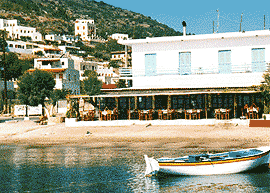Leros island, one of the Dodecanese islands of Greece, in the Aegean Sea, east of the Cyclades and off the southwest coast of Turkey.
 It is surrounded by numerous islets and is full of creeks, with many promontories and deep bays. Leros is mountainous (rising to 1,073 feet 327 m) and consists of three peninsulas joined by two isthmuses, with a total area of 20 square miles (53 square km). Bathing beaches are found on the east and west coasts. It is believed that Leros and Kalymnos just to the southeast comprise the Kalydrian isles referred to by Homer; it was famous in ancient times for its honey and for a temple of Artemis. Leros was first inhabited by Carians, then, successively, by Cretans, Ionians, Byzantines, and Rhodians; the last two quarreled over it until Rhodes took possession of it in 1319. Most of the property on the island belongs to women as a result of an old custom of handing down estates to the daughters. An annual festival derived from ancient Dionysian competitions is celebrated in houses where a marriage has taken place during the previous year. Adults compose satirical verses and children dressed as monks recite them. The chief economic activities of the island are agriculture and fishing; the fertile valleys in the centre of the island yield olives, figs, carobs, tobacco, fruit, and grapes for wine. Leros is linked to Piraeus, Rhodes, and Samos by ferry. Pop. (1981) 8,127.
It is surrounded by numerous islets and is full of creeks, with many promontories and deep bays. Leros is mountainous (rising to 1,073 feet 327 m) and consists of three peninsulas joined by two isthmuses, with a total area of 20 square miles (53 square km). Bathing beaches are found on the east and west coasts. It is believed that Leros and Kalymnos just to the southeast comprise the Kalydrian isles referred to by Homer; it was famous in ancient times for its honey and for a temple of Artemis. Leros was first inhabited by Carians, then, successively, by Cretans, Ionians, Byzantines, and Rhodians; the last two quarreled over it until Rhodes took possession of it in 1319. Most of the property on the island belongs to women as a result of an old custom of handing down estates to the daughters. An annual festival derived from ancient Dionysian competitions is celebrated in houses where a marriage has taken place during the previous year. Adults compose satirical verses and children dressed as monks recite them. The chief economic activities of the island are agriculture and fishing; the fertile valleys in the centre of the island yield olives, figs, carobs, tobacco, fruit, and grapes for wine. Leros is linked to Piraeus, Rhodes, and Samos by ferry. Pop. (1981) 8,127.
 It is surrounded by numerous islets and is full of creeks, with many promontories and deep bays. Leros is mountainous (rising to 1,073 feet 327 m) and consists of three peninsulas joined by two isthmuses, with a total area of 20 square miles (53 square km). Bathing beaches are found on the east and west coasts. It is believed that Leros and Kalymnos just to the southeast comprise the Kalydrian isles referred to by Homer; it was famous in ancient times for its honey and for a temple of Artemis. Leros was first inhabited by Carians, then, successively, by Cretans, Ionians, Byzantines, and Rhodians; the last two quarreled over it until Rhodes took possession of it in 1319. Most of the property on the island belongs to women as a result of an old custom of handing down estates to the daughters. An annual festival derived from ancient Dionysian competitions is celebrated in houses where a marriage has taken place during the previous year. Adults compose satirical verses and children dressed as monks recite them. The chief economic activities of the island are agriculture and fishing; the fertile valleys in the centre of the island yield olives, figs, carobs, tobacco, fruit, and grapes for wine. Leros is linked to Piraeus, Rhodes, and Samos by ferry. Pop. (1981) 8,127.
It is surrounded by numerous islets and is full of creeks, with many promontories and deep bays. Leros is mountainous (rising to 1,073 feet 327 m) and consists of three peninsulas joined by two isthmuses, with a total area of 20 square miles (53 square km). Bathing beaches are found on the east and west coasts. It is believed that Leros and Kalymnos just to the southeast comprise the Kalydrian isles referred to by Homer; it was famous in ancient times for its honey and for a temple of Artemis. Leros was first inhabited by Carians, then, successively, by Cretans, Ionians, Byzantines, and Rhodians; the last two quarreled over it until Rhodes took possession of it in 1319. Most of the property on the island belongs to women as a result of an old custom of handing down estates to the daughters. An annual festival derived from ancient Dionysian competitions is celebrated in houses where a marriage has taken place during the previous year. Adults compose satirical verses and children dressed as monks recite them. The chief economic activities of the island are agriculture and fishing; the fertile valleys in the centre of the island yield olives, figs, carobs, tobacco, fruit, and grapes for wine. Leros is linked to Piraeus, Rhodes, and Samos by ferry. Pop. (1981) 8,127. 
